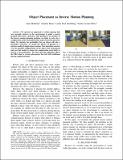| dc.contributor.author | Holladay, Anne E. | |
| dc.contributor.author | Barry, Jennifer | |
| dc.contributor.author | Kaelbling, Leslie P. | |
| dc.contributor.author | Lozano-Perez, Tomas | |
| dc.date.accessioned | 2014-05-15T20:39:33Z | |
| dc.date.available | 2014-05-15T20:39:33Z | |
| dc.date.issued | 2013-05 | |
| dc.identifier.isbn | 978-1-4673-5643-5 | |
| dc.identifier.isbn | 978-1-4673-5641-1 | |
| dc.identifier.uri | http://hdl.handle.net/1721.1/87018 | |
| dc.description.abstract | We present an approach to robust placing that uses movable surfaces in the environment to guide a poorly grasped object into a goal pose. This problem is an instance of the inverse motion planning problem, in which we solve for a configuration of the environment that makes desired trajectories likely. To calculate the probability that an object will take a particular trajectory, we model the physics of placing as a mixture model of simple object motions. Our algorithm searches over the possible configurations of the object and environment and uses this model to choose the configuration most likely to lead to a successful place. We show that this algorithm allows the PR2 robot to execute placements that fail with traditional placing implementations. | en_US |
| dc.description.sponsorship | National Science Foundation (U.S.) (NSF under Grants No. 1117325) | en_US |
| dc.description.sponsorship | National Science Foundation (U.S.) (NSF grant No. 1122374) | en_US |
| dc.description.sponsorship | United States. Office of Naval Research (ONR MURI grant N00014-09-1-1051) | en_US |
| dc.description.sponsorship | United States. Air Force Office of Scientific Research (AFOSR grant FA2386-10-1-4135) | en_US |
| dc.description.sponsorship | Massachusetts Institute of Technology (Angle Research and Innovation Scholarship) | en_US |
| dc.description.sponsorship | Singapore. Ministry of Education (grant to the Singapore-MIT International Design Center) | en_US |
| dc.language.iso | en_US | |
| dc.publisher | Institute of Electrical and Electronics Engineers (IEEE) | en_US |
| dc.relation.isversionof | http://dx.doi.org/10.1109/ICRA.2013.6631099 | en_US |
| dc.rights | Creative Commons Attribution-Noncommercial-Share Alike | en_US |
| dc.rights.uri | http://creativecommons.org/licenses/by-nc-sa/4.0/ | en_US |
| dc.source | MIT web domain | en_US |
| dc.title | Object placement as inverse motion planning | en_US |
| dc.type | Article | en_US |
| dc.identifier.citation | Holladay, Anne, Jennifer Barry, Leslie Pack Kaelbling, and Tomas Lozano-Perez. “Object Placement as Inverse Motion Planning.” 2013 IEEE International Conference on Robotics and Automation Automation (ICRA)
Karlsruhe, Germany, May 6-10, 2013. pp.3715-3721. | en_US |
| dc.contributor.department | Massachusetts Institute of Technology. Computer Science and Artificial Intelligence Laboratory | en_US |
| dc.contributor.department | Massachusetts Institute of Technology. Department of Electrical Engineering and Computer Science | en_US |
| dc.contributor.mitauthor | Holladay, Anne E. | en_US |
| dc.contributor.mitauthor | Barry, Jennifer | en_US |
| dc.contributor.mitauthor | Kaelbling, Leslie P. | en_US |
| dc.contributor.mitauthor | Lozano-Perez, Tomas | en_US |
| dc.relation.journal | 2013 IEEE International Conference on Robotics and Automation | en_US |
| dc.eprint.version | Author's final manuscript | en_US |
| dc.type.uri | http://purl.org/eprint/type/ConferencePaper | en_US |
| eprint.status | http://purl.org/eprint/status/NonPeerReviewed | en_US |
| dspace.orderedauthors | Holladay, Anne; Barry, Jennifer; Kaelbling, Leslie Pack; Lozano-Perez, Tomas | en_US |
| dc.identifier.orcid | https://orcid.org/0000-0002-8657-2450 | |
| dc.identifier.orcid | https://orcid.org/0000-0001-6054-7145 | |
| mit.license | OPEN_ACCESS_POLICY | en_US |
| mit.metadata.status | Complete | |
